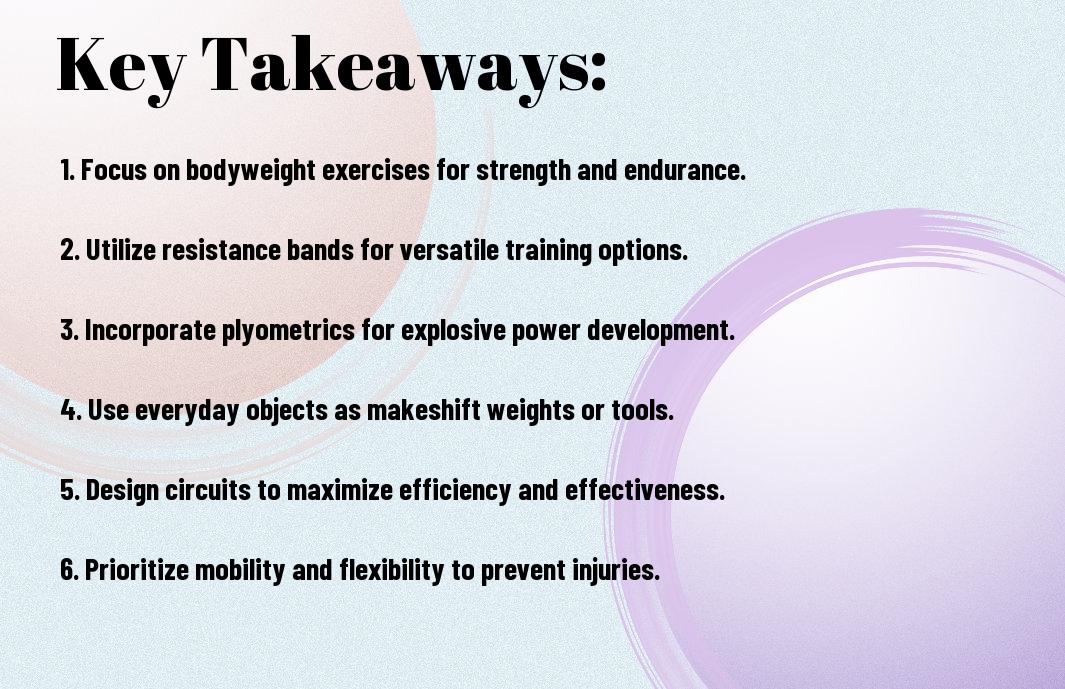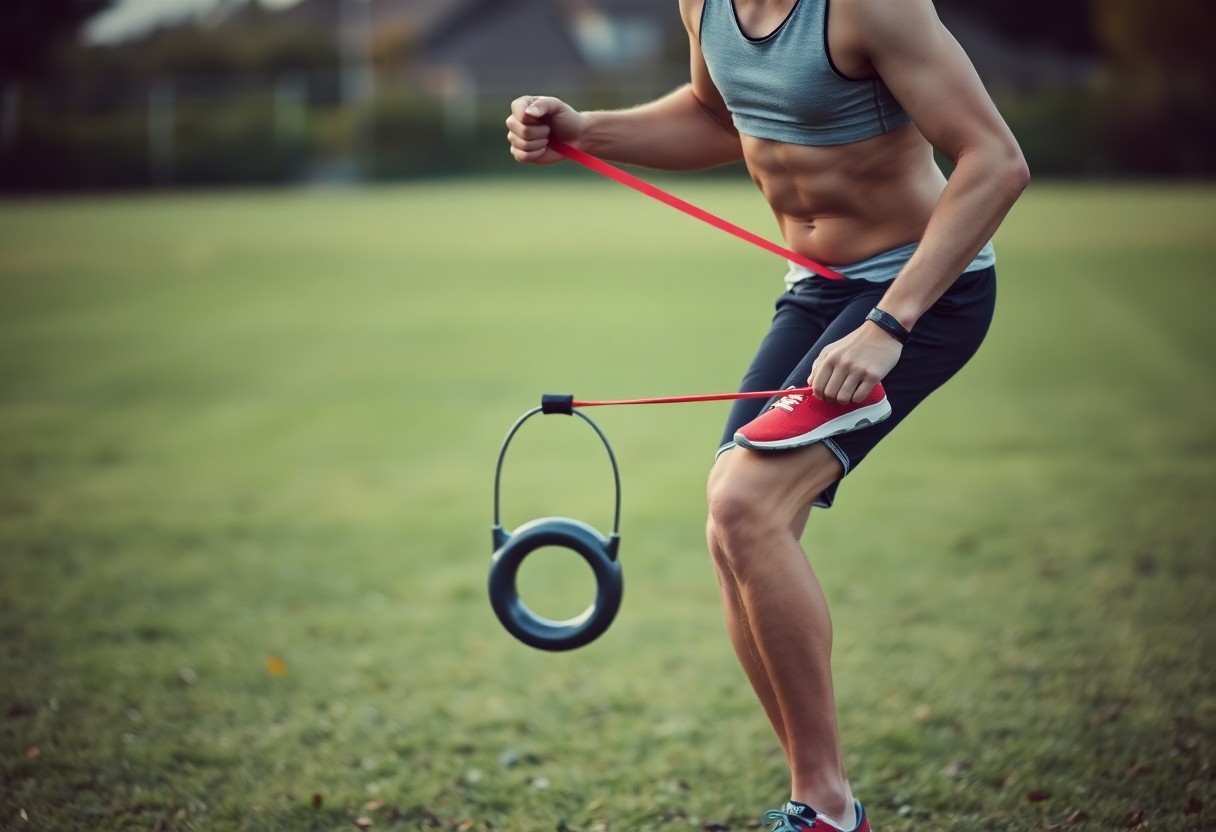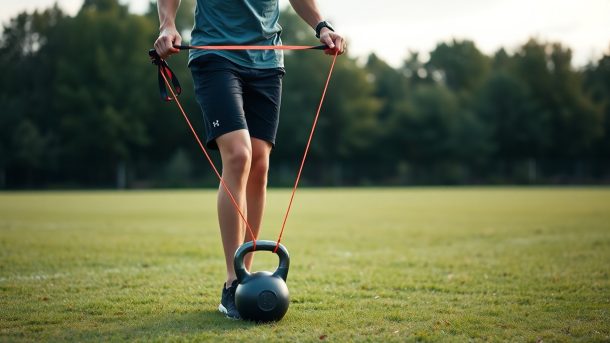It’s entirely possible to elevate your sports training without a full gym’s worth of equipment. You can achieve outstanding results by leveraging bodyweight exercises, improvised gear, and dedicated routines tailored to your specific athletic goals. This guide will provide you with effective techniques and resources to maximize your training sessions, allowing you to enhance your performance while keeping your workouts efficient and engaging. Get ready to explore how you can train smart and stay competitive with little more than your determination and creativity.
Key Takeaways:
- Bodyweight Exercises: Utilize your own body weight for strength training through push-ups, squats, and lunges to enhance overall fitness.
- High-Intensity Interval Training (HIIT): Incorporate HIIT workouts to boost cardiovascular fitness and endurance without the need for gym equipment.
- Creative Use of Everyday Items: Turn common household objects like chairs and backpacks into versatile training tools for resistance and balance exercises.
- Focus on Mobility and Flexibility: Engage in stretching routines and mobility exercises to prevent injuries and improve performance, which can be done with or without props.
- Set Clear Goals: Establish specific and measurable fitness goals to maintain motivation and track progress during your training sessions.

Understanding Minimal Equipment Training
Your training regimen doesn’t need to be limited by the availability of fancy equipment or a fully stocked gym. Minimal equipment training emphasizes the use of simple tools and your body weight to achieve effective workouts. This approach not only reduces the barriers to training but also allows for creativity and adaptability in your workouts, leading to improved strength, endurance, and flexibility.
Benefits of Minimal Equipment
At its core, minimal equipment training provides significant advantages, including increased accessibility, versatility, and the ability to engage in functional movements. With fewer resources needed, you can train virtually anywhere—at home, in the park, or even while traveling. Moreover, this method often emphasizes bodyweight exercises, which can enhance balance and core stability.
Types of Minimal Equipment
Understanding the types of minimal equipment available can help you tailor your workouts toward your goals. Here’s a list of some effective tools:
- Resistance bands
- Dumbbells
- Kettlebells
- Medicine balls
- Jump rope
Assume that each of these tools offers a different benefit, so you can mix and match them for varied training. Below is a breakdown of their potential advantages:
| Equipment | Benefits |
| Resistance Bands | Versatile for strength and flexibility |
| Dumbbells | Great for weight training and balance |
| Kettlebells | Excellent for dynamic workouts |
| Medicine Balls | Ideal for core strength and explosive movements |
| Jump Rope | Boosts cardiovascular fitness |
With this variety of tools, you can design a balanced workout routine that suits your individual needs. Ensure to include bodyweight exercises like push-ups, squats, and planks, which can enhance your overall fitness without any equipment. Combining these tools can make your workouts both effective and enjoyable.
- Focus on compound movements
- Incorporate progressive overload
- Keep workouts diverse
- Prioritize form over quantity
- Utilize intervals for maximum efficiency
Assume that by embracing minimal equipment training, you are equipping yourself with the necessary skills to train anywhere, paving the way for consistent and effective fitness progression.

Designing Your Training Program
Some athletes may feel overwhelmed when creating a training program with minimal equipment, but a well-structured plan can maximize your efforts. Start by identifying the key components of your sport and then incorporate those elements into your routine. Focus on bodyweight exercises and functional movements that can be performed anywhere. Tailor the program to fit your specific needs, and adjust it as you progress to ensure continual improvement.
Setting Goals
Goals are important for any training program. Establish both short-term and long-term objectives that are specific, measurable, and attainable. Whether you aim to increase your endurance, strengthen your core, or refine your skills, having clear milestones will keep you motivated and focused on your training journey.
Creating a Balanced Routine
Balanced training involves incorporating various components of fitness, ensuring that you address strength, flexibility, endurance, and skill development. Vary your workouts to include different exercises targeting various muscle groups and energy systems, preventing overuse injuries. By integrating a mix of cardio, strength, and mobility exercises into your routine, you can enhance overall performance and support holistic development.
Your balanced routine should include a combination of strength training, cardiovascular exercises, and flexibility work. Include exercises like push-ups, squats, lunges, and planks for strength, while running, cycling, or jumping rope can boost your endurance. Don’t forget to incorporate stretching and mobility drills to improve flexibility and prevent injuries. Evaluate your routine regularly, adjusting the intensity and focus based on your progress and specific sport requirements.
Key Exercises for Strength and Conditioning
Many athletes overlook the potential of training with minimal equipment. By incorporating a variety of key exercises, you can efficiently build strength and conditioning without the need for a gym. Focus on bodyweight movements, resistance bands, and other versatile tools to maximize your training. This approach enables you to enhance your performance in your chosen sport while developing overall fitness, whether at home or outdoors.
Bodyweight Exercises
An effective way to build strength is through bodyweight exercises. These movements, such as push-ups, squats, and lunges, utilize your own weight as resistance, making them accessible anywhere. By varying your routines and incorporating progressive overload, you can continuously challenge your muscles, improving endurance and strength without any equipment needed.
Resistance Band Workouts
Besides bodyweight exercises, resistance bands are a fantastic training tool that offers versatility and portability. These bands can provide resistance in multiple directions and can be easily adjusted to suit your fitness level. The lightweight and compact nature of resistance bands makes them simple to transport, enabling you to maintain your training regimen on-the-go.
Resistance bands not only enhance your strength training but also improve your flexibility and coordination. They can be used for a range of exercises targeting different muscle groups, from upper body to lower body workouts. Integrating band exercises like chest presses, rows, or lateral leg raises in your routine will help you build a balanced and resilient physique. With proper technique and consistency, resistance bands can be a powerful ally in your training toolkit.
Agility and Speed Training
To enhance your performance in sports, agility and speed training is vital. With minimal equipment, you can implement effective exercises that challenge your coordination, balance, and quickness. Incorporating these elements into your routine will not only improve your physical capabilities but also increase your overall athleticism, allowing you to outmaneuver opponents and excel in your chosen sport.
Drills for Improving Agility
Training for agility can be done anywhere, requiring just your bodyweight or simple markers. Drills like lateral shuffles, cone zigzags, and high knees can help sharpen your foot speed and coordination. Focus on performing these exercises at different intensities to push your limits and keep your workouts dynamic. Regular practice will lead to noticeable improvements in your agility over time.
Speed Training Techniques
To develop your speed, incorporate techniques like sprinting drills and interval training into your routine. These strategies can build your anaerobic capacity and enhance explosive power. Utilizing a flat surface or a track, concentrate on short bursts of high-intensity sprints to mimic the demands of your sport. This targeted approach will enable you to experience significant gains in your speed, elevating your performance on the field or court.
Understanding how to effectively implement speed training techniques is vital for improving your quickness. Focus on proper form and acceleration mechanics during your drills. Incorporate hill sprints or resistance training elements like harnesses or sleds (if available) to increase resistance and challenge your muscle fibers. Additionally, ensure adequate rest between sprints to allow for maximum effort on each attempt. This balanced approach not only boosts your speed but also prepares your body for competitive scenarios you may face in sports.
Incorporating Endurance Activities
Once again, you can enhance your athletic performance through endurance activities that require minimal equipment. Look for bodyweight workouts, running, or cycling in your local area to improve your stamina. For more tips, check out Trying to develop a no/minimal equipment strength training … to help you adapt your training effectively.
Cardio Options with Minimal Gear
After assessing your fitness goals, explore various cardio options that don’t require fancy equipment. Activities like jogging, jumping jacks, and burpees are excellent ways to elevate your heart rate and boost endurance without the need for a gym.
Interval Training Protocols
By implementing interval training protocols, you can maximize your endurance in a short amount of time. This approach involves alternating between periods of high-intensity effort and low-intensity recovery.
With interval training, you can vary the duration of work and rest intervals according to your fitness level. Start with 30 seconds of sprinting, followed by 1 minute of walking or jogging. As you improve, experiment with different ratios, such as 1:1 or 2:1, to further challenge yourself and enhance your cardiovascular efficiency.
Tracking Progress and Staying Motivated
After setting your fitness goals, tracking progress and staying motivated become important elements of your training journey. Utilizing simple methods to measure your achievements, whether through apps, journals, or periodic self-assessments, can keep you engaged and focused on reaching your objectives. Find a system that works for you, and regularly evaluate your advancements to maintain enthusiasm and commitment to your training process.
Monitoring Training Outcomes
The key to understanding your growth lies in monitoring your training outcomes. By keeping records of your workouts, including repetitions, duration, and intensity, you can visualize your progress over time. This not only helps you identify areas for improvement but also serves as a motivating factor as you see how far you’ve come.
Strategies for Maintaining Motivation
Around your training schedule, incorporate strategies that will help keep your motivation levels high. Engaging with a community, setting smaller milestones, and varying your workouts can create a sense of excitement and help you push through challenging moments. Connecting with others who share your goals can also provide a support network to cheer you on.
Considering different techniques can further enhance your motivation. Setting specific, attainable goals helps break the long journey into manageable steps. Celebrate each accomplishment, no matter how small, to build self-confidence and create positive reinforcement. Additionally, designing a varied routine can prevent boredom, making your training sessions stimulating and enjoyable. By actively involving yourself in your progress and surrounding yourself with positivity, you’ll find it easier to stay committed to your training regimen.
Final Words
Upon reflecting on how to train for sports with minimal equipment, you can achieve significant results by focusing on bodyweight exercises, functional movements, and creative use of everyday items. Incorporating flexibility, strength, and endurance workouts will keep your training well-rounded. Always set clear goals and create a consistent schedule to stay motivated. Emphasize the importance of proper form to prevent injuries and enhance performance. With determination and resourcefulness, you can elevate your athletic abilities without the need for a fully equipped gym.
Q: What types of exercises can I do with minimal equipment for sports training?
A: There are numerous exercises you can incorporate into your training regimen with minimal equipment. Bodyweight exercises such as push-ups, squats, lunges, and planks are excellent for building strength and endurance. Additionally, using items like resistance bands or a jump rope can enhance your workouts. For agility training, cone drills can be done with household items like water bottles. By combining different bodyweight movements and functional training, you can create a well-rounded program that targets the necessary muscle groups for your sport.
Q: How can I ensure that my training is effective without access to a gym or specialized gear?
A: To maximize the effectiveness of your training without gym equipment, focus on creating a structured workout plan that incorporates progressive overload. This can be achieved by increasing the intensity of your workouts over time through higher repetitions, shorter rest periods, or more challenging variations of exercises. Consistency is key—aim for regular workouts and track your progress. Additionally, prioritize proper nutrition and hydration, as they significantly affect performance and recovery. Using online resources for workout routines can also provide new ideas to keep your training dynamic.
Q: How can I stay motivated to train for my sport with limited equipment?
A: Staying motivated can be challenging, especially when training with minimal resources. Setting specific, measurable, and achievable goals for your training can help maintain focus and direction. Mixing up your workouts by trying different exercises or training styles, such as high-intensity interval training (HIIT), can also make sessions more enjoyable. Engaging with friends or joining online fitness communities can further enhance motivation, as shared goals and accountability can provide additional encouragement. Lastly, celebrate small victories and progress, as recognizing your improvement can boost your enthusiasm for continued training.

